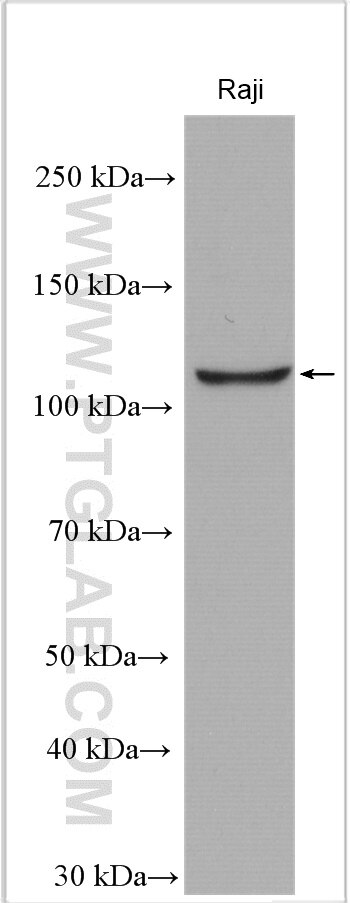Validation Data Gallery
Tested Applications
| Positive WB detected in | Raji cells |
Recommended dilution
| Application | Dilution |
|---|---|
| Western Blot (WB) | WB : 1:500-1:3000 |
| It is recommended that this reagent should be titrated in each testing system to obtain optimal results. | |
| Sample-dependent, Check data in validation data gallery. | |
Product Information
28403-1-AP targets TAOK3 in WB, ELISA applications and shows reactivity with Human samples.
| Tested Reactivity | Human |
| Host / Isotype | Rabbit / IgG |
| Class | Polyclonal |
| Type | Antibody |
| Immunogen | TAOK3 fusion protein Ag29158 相同性解析による交差性が予測される生物種 |
| Full Name | TAO kinase 3 |
| Calculated molecular weight | 105 kDa |
| Observed molecular weight | 100-105 kDa |
| GenBank accession number | BC002756 |
| Gene Symbol | TAOK3 |
| Gene ID (NCBI) | 51347 |
| RRID | AB_2918158 |
| Conjugate | Unconjugated |
| Form | Liquid |
| Purification Method | Antigen affinity purification |
| UNIPROT ID | Q9H2K8 |
| Storage Buffer | PBS with 0.02% sodium azide and 50% glycerol , pH 7.3 |
| Storage Conditions | Store at -20°C. Stable for one year after shipment. Aliquoting is unnecessary for -20oC storage. |
Background Information
TAOK3 (Serine/threonine-protein kinase TAO3) is also named as DPK, JIK, KDS, MAP3K18. It belongs to the STE Ser/Thr protein kinase family. TAOK3 acts as an activator of the p38/MAPK14 stress-activated MAPK cascade. In response to DNA damage, it is involved in the G2/M transition DNA damage checkpoint by activating the p38/MAPK14 stress-activated MAPK cascade, probably by mediating phosphorylation of upstream MAP2K3 and MAP2K6 kinases. The protein can also be autophosphorylated (PMID:20949042).
Protocols
| Product Specific Protocols | |
|---|---|
| WB protocol for TAOK3 antibody 28403-1-AP | Download protocol |
| Standard Protocols | |
|---|---|
| Click here to view our Standard Protocols |
